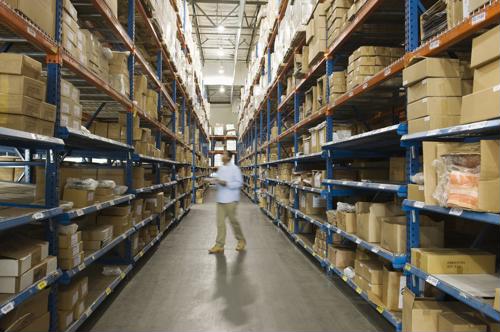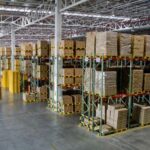
As the supply chain evolved, so did the meanings of different words.
The term "warehouse" used to be the catch-all word to describe the place where inventory was stored, as well as any additional functions that they served. Nowadays, there are specialized terms that are used to explain the nuances of multi-purpose storage facilities. Terms like "fulfillment center" and "distribution center" have become more and more commonplace with the rise of ecommerce — all with slight differences that could change the subject matter of what you are talking about.
In this article, we're going to explain the nuances of these industry-specific terms and decipher how exactly they differ from one another.

What is a warehouse?
The godfather of all supply chain buildings, a warehouse is a facility that stores a company's inventory for an extended period of time. Think of a warehouse as a progenitor of a company's inventory — chances are, most items that you've encountered in a department store once came through a warehouse.
Traditionally, warehouses are large buildings that simply hold items, which means that they can exist anywhere where there is a lot of empty space. Because warehouses serve this singular function of storing inventory, they tend to spring up in largely undeveloped areas that are outside of major cities to save on rent.
When a company orders new inventory, those products are sent to the warehouse, cataloged and then stored away. Then, when the company needs to move their stock, the product is already ready to be shipped.
What is a fulfillment center?
Warehouses evolved into fulfillment centers to meet customer demand.
As ecommerce became more prominent, companies looked for new ways to upgrade their supply chain model. This meant shipping orders to consumers faster, smoother and in pristine condition. In 2020, those practices were put to the ultimate test when consumers spent about $861.12 billion on ecommerce with U.S. merchants alone, according to a study by Digital Commerce 360.
To align with the 24/7 online shopping cycle, companies had to quickly adapt to meet consumer demand. Shipping an item from the warehouse to a third-party distributor was too slow — products got lost along the way, shipping times became lengthier and customers became more frustrated. Multiply these conditions across thousands of orders and a firm's ecommerce system could quickly fall apart. Companies needed to cut out the middleman, and that's where the fulfillment center came into play.
Put simply, fulfillment centers are a type of warehouse that also participates in order fulfillment. Instead of solely storing items, a fulfillment center has a team of pickers and packers who are given lists of customer orders. They then find the products in the inventory stacks, bundle the orders together and ship them out to customers. This saves companies a lot of time between getting the initial order in and the eventual shipment of the product.
Because so many items are moving in and out of a fulfillment center at all times, it is less a warehouse and more a short-term storage facility. While some companies may choose to give a fulfillment center the dual purpose of long-term and temporary storage, its primary goal is to get the customer's order shipped out as quickly as possible.
This is also why many companies sign contracts with third parties to help oversee and manage these operations. Fulfillment centers can also be called third party logistics warehouses (3PL) due to the addition of these contracts. Add onto that additional agreements with carriers like USPS, UPS and FedEx and it's clear that fulfillment centers are the sites of collaborative efforts.
With the help of such companies, the process from the web store to the customer can be a breeze.
What is a distribution center?
The term distribution center may be a little confusing at first — especially because of how close it may seem to fulfillment center. However, they operate differently.
Unlike a fulfillment center, a distribution center does not ship directly to customers. Instead, it's a depot that is primarily used for intra-company operations. Distribution centers serve as transit points, moving inventory from place to place.
A good way to think of distribution centers is by comparing them to layovers at an airport. If a customer orders an item online from a particularly far warehouse, the item may get shipped from that warehouse to a distribution center before making its way to a fulfillment center. These centers exist as transit points. Switching between different modes of transportation, like moving an item via air cargo to truck transportation, all happen at a distribution center.
Another way that distribution centers are used is as temporary holding places for products, especially for very popular items in a brick-and-mortar location. Distribution centers are able to send inventory directly to physical storefronts quickly. Grocery stores that always run out of potatoes, for example, may keep some extra in stock on standby at a local distribution center so that they can replenish their supply efficiently.

Putting it all together: A sample supply chain
Suppose your customer decides that they want to order a t-shirt from your clothing store. Once they hit the "Pay Now" button, the order begins the process of moving from one establishment to the next.
Your warehouse receives the order information and checks it against your inventory to make sure that you have it in stock. Once your team finds the item on the shelves, they pack it along with any other pieces of inventory heading in the same direction and fly it via plane to a distribution center. Your distribution center takes the package and transfers it via truck to a fulfillment center near the customer. Once there, an employee from the fulfillment center finds and picks the order and then sends it via a package delivery company right to your customer's door.
Voila! Your t-shirt has just gone through the entire supply chain system.
SFG can help you simplify the process
At SFG, our goal is to make your customer fulfillment a lot smoother thanks to FlexOMS, our order management system. Let our program do the hard work for you.
Manage customer orders and streamline your fulfillment operations with us. Contact SFG today to learn more about FlexOMS.









